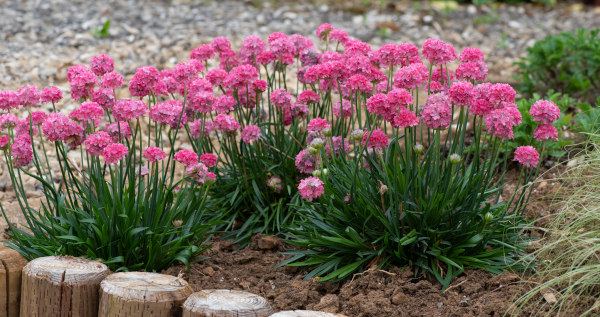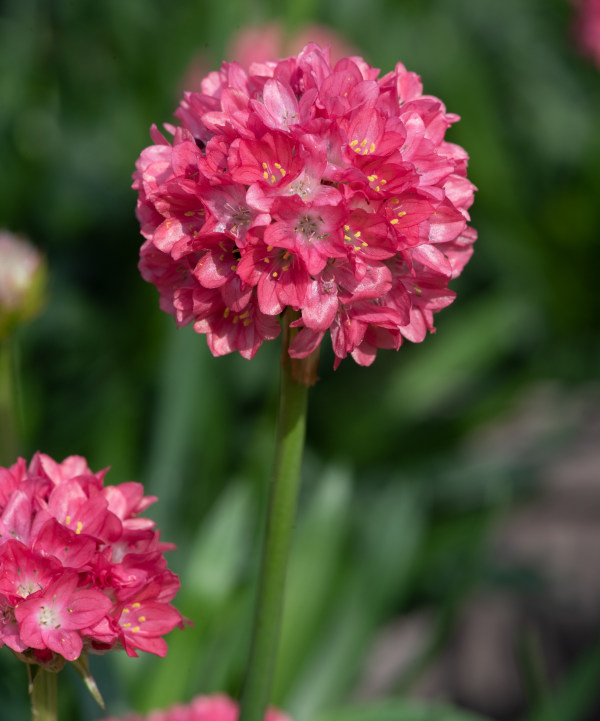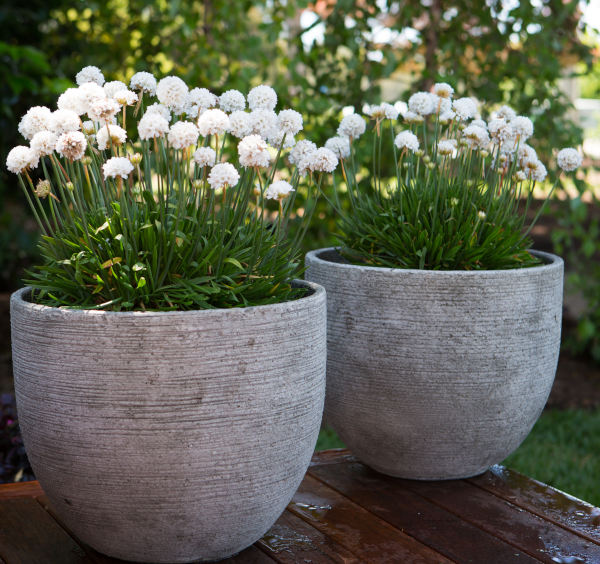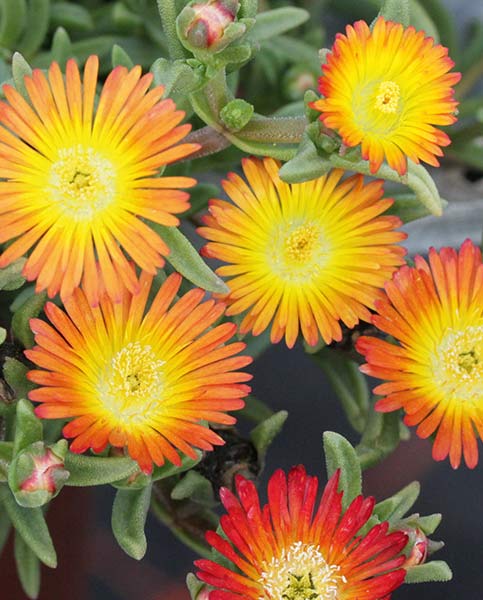How to grow Armeria
Originating from sea cliffs and mountainous areas throughout the world, these tough little hummock-forming, evergreen perennials are happy in challenging, windswept conditions, though also make attractive garden flowers and have been cultivated to offer a range of colours and forms. While there are many species, in the UK we are most familiar with Armeria maritima, our native sea thrift.
Most species form mounds of grass-like, evergreen foliage and bear small, globe-shaped flowerheads for several months from late spring. Requiring next to no ongoing care, this plant is an excellent choice for a low maintenance garden. Its nectar-rich flowers are also highly popular with bees and other pollinators.

Key Information
Position
Soil Conditions
Hardiness


Where & when to plant Armeria
For best results, plant in autumn or spring. An autumn planting can be done by those gardening in mild conditions (and broadly speaking, this is the southern half of the UK). For those liable to cold winters, it is best to wait until spring (generally the northern half of the UK). Planting can also be carried out in summer, though be prepared to water regularly.
Easily tolerating strong winds and salty conditions, armeria is an ideal groundcover choice for a coastal garden. It also suits any sunny, well-draining spot such as a rockery, a hot, dry sunny bank, the front of a border, the nooks and crannies found in walls and paving, or even a green roof. Armeria can also be grown in pots and troughs filled with a gritty, well-draining compost mix.
How to plant Armeria
- For planting in the ground, clear the chosen area of weeds.
- Unless you already have poor, sandy soil, now is the time to improve drainage by digging in some horticultural grit or sharp sand.
- Dig a planting hole several times larger than the root ball.
- Place the plant in the hole, ensuring the top of the root ball sits level with the surface of the soil. Too low and the plant may rot, too high and the roots can dry out.
- Backfill with soil and firm in gently.
- Soak well with water.
- Mulch with horticultural grit.
- For planting into a wall or crevice, simply excavate as large a cavity as you can, loosely fill with a sandy soil or compost mix, and push the small plant in. Compress with your fingers so that it holds tight, and thoroughly wet the soil/ compost with a gentle spay of water.
- For planting in containers, first choose an appropriate container, ensuring there are plenty of drainage holes.
- Use a good quality potting compost with a high ratio of horticultural grit mixed in (aim for around 40% grit), and, if not already present in the compost (check the description on the bag) some slow-release fertiliser granules.
- Start by partially filling the pot with compost; enough so that when placed on it the upper surface of the root ball is about 3cm lower than the top of the pot.
- Infill all the space surrounding the root ball with compost, firming down with your fingers then adding a little more so the plant is held tight.
- Pick up the pot (if you can) and lightly tap on the potting bench or ground a few times to help further settle the compost around the plant.
- Soak well with water.
- A mulch with horticultural grit will look attractive and help to prevent a ‘cap’ or crust forming on the top of the compost (something container plants can suffer due to the artificial nature of their watering).

What to plant with Armeria
We particularly love seeing the brilliant yellow flowers of acacia combined with purple-blues and zingy lime greens. If you have the sunny, protected spot needed to grow this tree outside, you could go for the half-hardy climbers hardenbergia and sollya, perhaps with a generous clump of euphorbia as lower storey planting.



How to care for Armeria
Pruning and Deadheading
We don’t often say this, but armeria requires practically no attention at all. You can deadhead spent flowers if you wish to keep the plant looking tidy and encourage further blooming, though quite honestly it will do almost as well left to its own devices. What’s more, the papery seedheads you get from leaving spent flowers intact make attractive features in their own right.
Watering
During the first year in the ground, water your armeria regularly until established (i.e., the first few weeks), and then only in very hot dry spells after this. From year two onwards, armeria is known to be extremely drought tolerant so shouldn’t require any attention in this respect.
Container-grown armeria is a little different and will need watering throughout every growing season. Aim to water deeply and thoroughly, then allow the compost to almost dry out completely before repeating. This is to avoid having the roots sitting too wet, something these drainage-loving plants dislike.
Feeding
Armeria hails from naturally poor soil, so does not usually need any extra fertiliser when grown in the open ground.
Those in containers may, over time, benefit from some slow-release, low-nitrogen feed. This can either be mixed into the compost when potting/ repotting or applied as a ‘top dress’. This is when you scrape away the top 5cm of compost in a container and replace it with a fresh mix containing a small amount of feed. Aim to carry out every few years in spring.
Cold Protection
The hardiness of armeria can range from H4 to H7.
Those with a hardiness rating of H4 can cope with temperatures dipping to between -5°C and -10°C, so may struggle further north or in very harsh winters, particularly if drainage is poor and the roots sit in wet soil. They make more vulnerable container plants, and it can be worth wrapping their pots in bubble wrap, fleece, or hessian to protect the roots against frost.
Armeria with an H5 rating can withstand between -10°C and -15°C and should be fine in all but the most exposed spots. Again, protect those grown in containers as they don’t have the protection and insulation of soil all around them.
A H6 rating means fine with temperatures as low as -15°C to -20°C, and therefore able to cope with winter pretty much anywhere throughout the UK. Once again, protect the roots of those grown in containers.
H7 means essentially indestructible! These will cope with temperatures dipping below -20°C and are unlikely to be troubled by winter.
It is important to note, however, that for drainage-loving plants such as armeria, excessive moisture around the roots can significantly reduce chances of winter survival, and even the hardiest of plants may perish if they sit in permanently wet soil.
Pests and Diseases
Armeria is considered problem-free.
How to propagate Armeria
The quickest and easiest way to propagate armeria is by lifting and dividing established clumps in early spring. As well as providing new plants this has the added benefit of reinvigorating existing clumps. Allow at least 2-3 years between each division so the plant can sufficiently re-establish.
- Choose a day when the soil is not frozen or waterlogged.
- Dig the plant out of the ground.
- Shake off any excess soil.
- Separate the plant into sections using either swift, cutting blows with a sharp spade, or two forks inserted back-to-back with tines touching, handles then pushed together to prise the plant apart.
- Discard old, damaged, or surplus pieces, keeping healthy, vigorous material.
- Replant decent-sized pieces where desired, and any smaller bits can be potted up.
- Water well until fully established.
* Many plants carry Plant Breeders Rights and cannot be propagated for commercial purposes.
Common Armeria questions
- Does armeria spread?
Given the right conditions, armeria will self-seed readily. This is usually seen as a good thing by gardeners keen for it to naturalise itself in the surrounding area, though if necessary can be prevented by the removing of spent flowers before they form seedheads. - Does armeria need full sun?
In short, yes! This is a sun-loving plant which needs a bright, open spot to thrive. - How often should you water armeria?
Give it a good watering in when you plant it, then water a few more times in the following weeks until the roots have become established. After this, it should only need watering in very hot dry periods during the first growing season, and then beyond this not at all. See our ‘Watering’ section above for more information.




